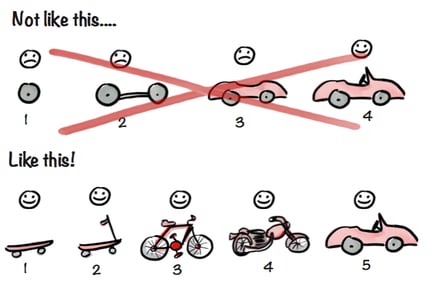3 min read
Do you know something that the entire global workforce is doing currently?
Spending more time in front of the screen, be it a laptop or phone, and interacting with brands through self-service transactions and sometimes chatbots.
For cutting-edge companies, conversational processes and interactions are becoming a dominant method of communication offered to their customers.
But, are businesses offering good conversational customer experiences?
What exactly is needed to master the art of conversational processes? As a company whose main service centres around introducing and setting up customer-facing processes for insurers, here are some crucial things we have discovered:
The truth about conversational processes
Customers value usefulness over pleasantness
This needs clearing up right off the bat: if your interaction, product, processes are not solving a customer problem, they won’t last long no matter how pleasant they are.
To put this into practice, focus on the frictions in the current customer journey. A classic example is waiting in line for ages for a claim. What can you do to remove or minimize this pain point?
It’s best to adopt an MVP approach to control over-dreaming in this area. What’s the maximum value that can be delivered with minimum effort?
It’s not just a piece of technology
As conversational interfaces are discussed within the innovation area along with the broader topic of Artificial Intelligence, the ordinary tendency is to look at them uniquely from a tech perspective - as just another SaaS product.
But, as Jeff McMillan, Chief Analytics and Data Officer at Morgan Stanley said:
‘You can create a really bad bot in ten minutes with a lot of technology today. It takes months and even years to actually do it the right way.’
At the opposite end of the spectrum is the risk of overlooking capabilities that such technologies should offer because they are overshadowed by expensive and trendy ones like NLP (Natural Language Processing).
When thinking about chatbots, people tend to think about an open conversation with a robot. Whatever we ask/write to the robot, it will comprehend and answer back accordingly. This particular feature falls under the domain of NLP and represents one approach to the conversational world.
Today, NLP technology is still within the research domain (average accuracy 60-70%) and cannot meet business and customer expectations at a sustainable price, even less for longer and technical conversations required by customers interacting with household brands.
The point Spixii has been stressing since the beginning is that most of the time NLP is not needed from day one, mainly when translating process-heavy transactions (eg. manage a claim or buying a policy) into conversational processes. In our experience, the best approach is close to the MVP concept. Instead of pushing to the market an overpromising and deceiving solution, we promote "rule-based" conversations able to deliver value from the beginning and then use data gathered through the conversations to improve the process executed continuously and the conversation itself.
It’s not just a matter of designing a new interaction
Often, the temptation is to look at the conversational world uniquely from a design perspective. The focus shifts to the design of a ‘good user experience’ featuring a nice user interface and programming a conversation that customers might enjoy.
However, the primary focus should be on analysing current customer-facing processes and defining a new one that brings value to both the business and customer. Design is an integral part of this quest but not the only one.
Conclusion
AI and related technologies should be designed in collaboration with business and process owners. It’s 10% about algorithms, 20% about technology, and 70% is the business application. The latter encompasses people, processes, and a culture of change and strategy.
It’s time to switch from ‘how smart is my bot?’ to ‘how can a bot improve my business processes?’ In the first question, we are focusing on a vanity metric. In the second one, we are talking about critical business value. So, what are you waiting for? It’s time to create actual value for both you and your customers. Spixii Conversational Process Automation (CPA) can help you do just that. Click here to learn more.

